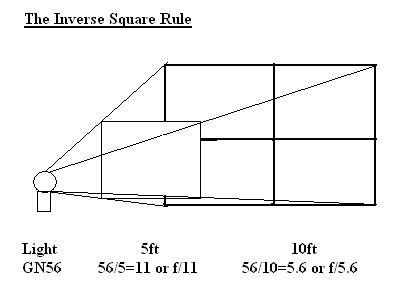Guide
Numbers
When automatics fail or your gear is not fully compatible with each other component it may well be possible to make good exposures manually.
Remembering that shutter speed except the fastest have no effect on exposure as flash is a very bright but of very short duration.
What is a Guide Number?
A number derived from the aperture you use when the flash to subject distance is ten feet [or three metres] with film or sensitivity set to 100 ISO. Can be imperial 10ft or metric [3m]
Example
Lets say with a given flash unit you get a good exposure with the flash to subject distance of ten feet when using the aperture of f/8
That means that your flash gun has a GN of 80 [24]

The above diagram was draw assuming a guide number of 56 which is a common power for smaller flashguns. Since light falls off in strength at the inverse square of the distance it travels we find that it is four times as strong at half the distance .. here five feet means we have to close down two stops compared to ten feet.
ie GN56 divided by 5ft equals f/11
GN56 divided by 15ft gives us 3.7 ... near enough to f/4
Move forward to 14ft gives us f/4 exactly :-)
But I'm using 400 ISO?
400 ISO is four times the sensitivity of 100 ISO so we close down two stops. So the original GN 80 doesn't become 320 but GN160. Easy to work out if you relate the number to f/stops. To get a GN of 320 you would need to be using 1600 ISO.
Limitations with 'on-board' flash
With some exceptions it is likely that the onboard flash is not very strong and any great distances claimed for it come from it automatically raising the ISO sensitivity to cope with the low light levels being reflected back from more distant subjects.
P&S and Pro-sumer cameras when in automatic modes default to quite slow shutter speeds, 1/60, which may result in some blurr from camera shake or subject movement recorded by ambient light.
Because the flash is relatively weak they also default to maximum [wide open] aperture which results in less depth of field.
Unless you can separate the flash from the camera it is usually best to have all the subjects at the same distance from the flash on the camera due to the inverse square rule. Backgrounds will quickly go dark for the same reason if they are any distance behind the subjects.